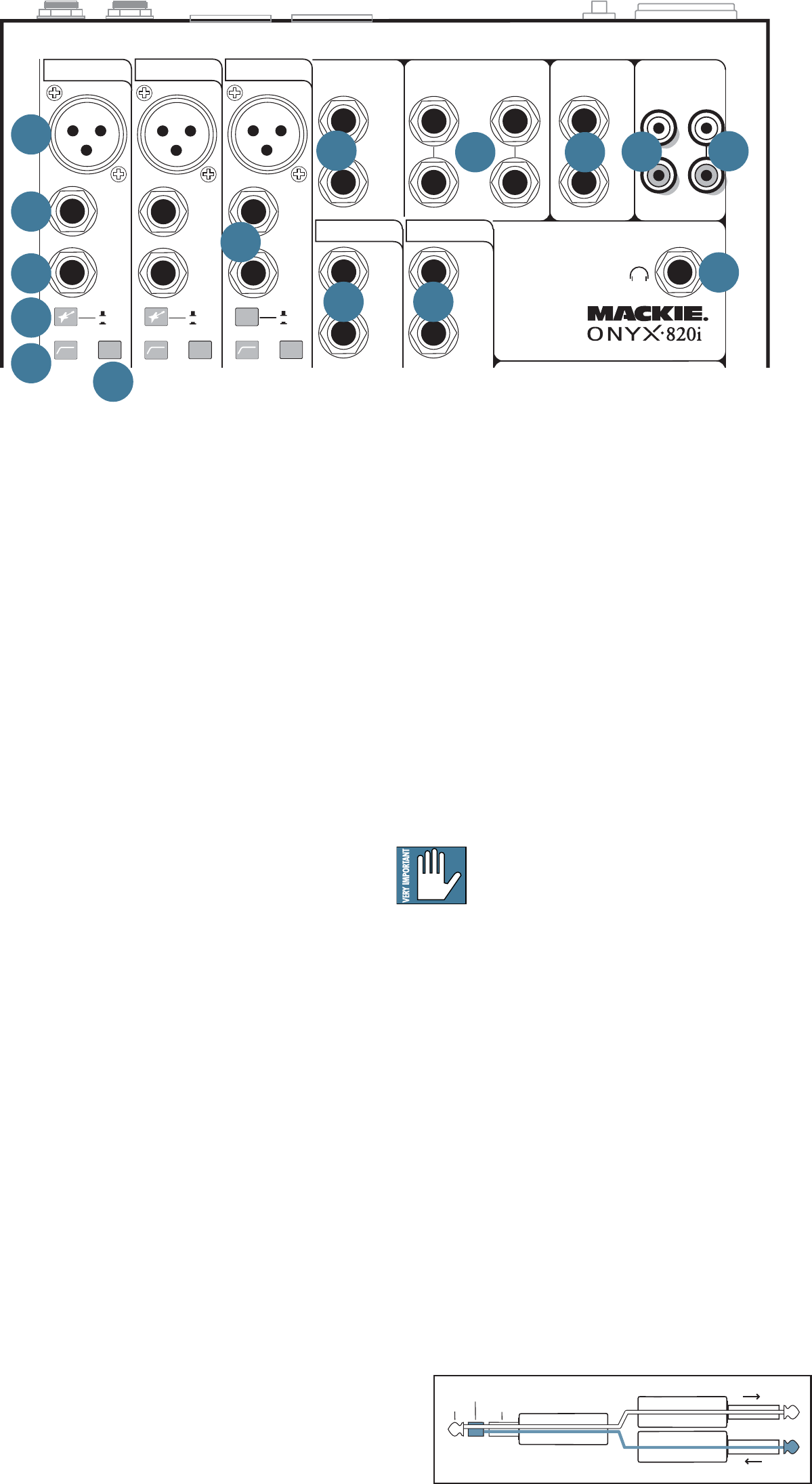
14 Onyx 820i
PHANTOM POWER
Most modern professional condenser mics require
48V phantom power, which lets the mixer send
low-current DC voltage to the mic’s electronics through
the same wires that carry audio. (Semi-pro condenser
mics often have batteries to accomplish the same
thing.) “Phantom” owes its name to an ability to be
“unseen” by dynamic mics (Shure SM57/SM58, for
instance), which don’t need external power and aren’t
affected by it anyway.
Phantom power for each channel can be selected
using that channel's phantom [20] switch.
Never plug single-ended (unbalanced)
micro phones, or ribbon mics into the mic
input jacks if phantom power is on. Do not
plug instrument outputs into the mic XLR input jacks
with phantom power on, unless you are certain it is safe.
9. INSERT (Ch. 1 and 2)
These unbalanced 1/4" jacks on channels 1 and 2,
are for connecting serial effects processors such as
compressors, equalizers, de-essers, or fi lters. The insert
point is after the gain control [23] and low cut fi lter
[19], but before the channel’s EQ and level [36]. The
channel signal can go out of the insert jack to an
external device, be processed and come back in on the
same insert jack. To do this requires a standard insert
cable that must be wired thusly:
Tip = send (output to effects device)
Ring = return (input from effects device)
Sleeve = common ground
Connection Section
This is where you plug in things such as: microphones,
line-level instruments, guitars, effects, a recorder, PA
system, powered monitors, powered subwoofer, etc.
Check out the hookup diagrams for some connection
ideas. See Appendix B (page 29) for further details and
some rather lovely drawings of the connectors you can
use with your mixer.
8. MIC INPUTS
This is a female XLR connector, that accepts a
balanced microphone input from almost any type of
microphone. The microphone preamps feature our Onyx
design, with higher fi delity and headroom rivaling any
standalone mic preamp on the market today.
The XLR inputs are wired as follows:
Pin 1 = Shield or ground
Pin 2 = Positive (+ or hot)
Pin 3 = Negative (– or cold)
We use phantom-powered, balanced microphone
inputs just like the big studio mega-consoles, for exactly
the same reason: This kind of circuit is excellent at
rejecting hum and noise. You can plug in almost any
kind of mic that has a standard XLR-type male mic
connector.
Professional ribbon, dynamic, and condenser mics all
sound excellent through these inputs. The mic inputs
will handle any kind of mic level you can toss at them,
without overloading.
Microphone-level signals are passed through the
mixer's splendid microphone preamplifi ers to become
line-level signals. The mic input of hybrid channels 3-4
is fed equally to channels 3 and 4.
“tip”
This plug connects to one of the
mixer’s Channel Insert jacks.
“ring”
tip
ring
sleeve
SEND to processor
RETURN from processor
(TRS plug)
48V
48V
48V
LINE
BAL/UNBAL BAL/UNBAL
O
N
Y
X
M
I
C
P
R
E
INSERT INSERT
O
N
Y
X
M
I
C
P
R
E
O
N
Y
X
M
I
C
P
R
E
(MONO)
L
R
L
R
L
(MONO)
R
BAL/UNBAL
L
(MONO)
R
BAL/UNBAL
L
(MONO)
R
BAL/UNBAL
TAPE
IN OUT
L
R
AUX RETURN
1
21
2
AUX SEND MAIN OUT
HI
-
Z
LINE
-10dB
+
4dB
HI
-
Z
LINE
PREMIUM ANALOG MIXER
w/ PERKINS EQ & FIREWIRE
1 2 3-4
LINE IN 5-6 LINE IN 7-8
BAL/UNBAL BAL/UNBAL BAL/UNBAL
1
LINE
2
LINE
8
9
10
11
12
11
13
11
14
15
16
17
18
19
20


















